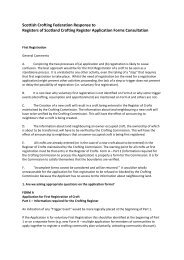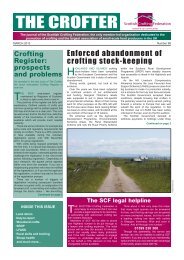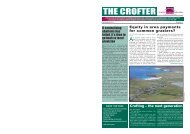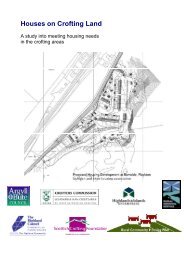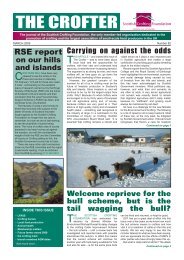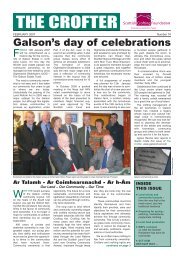Crofter 93 - Scottish Crofting Federation
Crofter 93 - Scottish Crofting Federation
Crofter 93 - Scottish Crofting Federation
- No tags were found...
Create successful ePaper yourself
Turn your PDF publications into a flip-book with our unique Google optimized e-Paper software.
2 THE CROFTER, dECEmbER 2011THE CROFTER, dECEmbER 2011 3Message from the chair...the scF annual gathering,held in sabhal mor ostaigin skye, was the highlightof the last few months. No, thehighlight of the year.It was a great opportunityto visit another island and thehospitality shown to us by smoDirector's blog...IWAs All set to be hoppingmad when I heard that thescottish Government hadignored the recommendationmade by the bull hire review groupon which I represented the scF.We had recommended thata new stud farm be built atbalrobert, which is more remotethan knocknagael in relation tothe city of Inverness. And thescottish Government did notlisten after the months of researchand discussion undertaken by thereview group. however, I thoughtI had better get it straight fromthe horse’s mouth and spoke toJohn cowan, the farm managerat knocknagael.the news was good. planshave been submitted to highlandcouncil for a new state-of-the-artstud farm at knocknagael which, allbeing well, will be up and runningby November 2012. An engineer’sreport on the balrobert siteconcluded that it would be scarilyexpensive to develop. however,it has not been lost on me that inwas excellent. In shetland wehave stunning views but skye wasjust lovely, especially as we werestaying in the college pent-houseaccommodation. the sunrisein the morning was outstandingand as the day progressed theweather deteriorated into veryrough weather and seas. What abeautiful place.We had a fair range ofexcellent speakers from allover scotland, making verygood, interesting listening whichgenerated discussion over thetwo days. our own minister,stewart stevenson, gave theopening address. the croftingconnections school childrenwere a welcome addition too atthe college, where they sang andplayed to a captivated audience.A big thank you goes to them.Vote for your commissionersWe remINDeD reADers in the last issue of The <strong>Crofter</strong> thatthe crofting reform (scotland) Act 2010 makes provision toelect commissioners to the crofting commission, as it will becalled, to make it more democratic and accountable.A consultation on procedure closed on 5th october, the results ofwhich should be publicised soon. the proposals put forward seem tobe workable.With the opportunity to vote for new crofters commissioners comesthe responsibility to vote. It is vital that as many eligible crofters aspossible vote in the elections next year.2001 when I was a commissionerat the crofters commission, planswere drawn up for a new build atknocknagael but the plug waspulled on the proposal.the current knocknagaelbuildings will be demolished, thesite levelled and a ‘comprehensiveflagship stud farm’ built. It willalso be a centre for training stafffrom sepA, sNh, hse, sAc andothers interested in agriculturalissues. there will only be two bullsto a pen – and it will be cheaper,easier and so much safer for manand beast.the management of the schemewill no longer be the responsibilityof the crofters commission butwill be administered by sGIrpIDin Inverness and called thescottish Government bull schemeknocknagael. so the bull schemehas been well and truly saved andI believe the review group playeda big part in that.so once again crofters can saythey have a department bull – justlike the old days.A maybe not very exciting, butvery important, issue is happeningat the moment – cAp reform,which seems to have been goingon for ever. but we now haveproposals from the europeancommission that go to theeuropean parliament and councilfor modification and approval; sowe still have ample opportunity toinfluence the outcome and try toget a fairer deal for scotland. Andwe have to negotiate in scotlandfor a fairer deal for crofters.We have had SCF officials inedinburgh, london and brusselsand will continue to fight.As a crofting assessor, I amlooking forward to the assessors’conference in Inverness. We willbe discussing, amongst otherthings, common grazings. Wemust make more use of them andEleanor Arthurprotect this very valuable resource.there will also be a session on thecrofting commission electionswhich will take place next spring.please get involved and eitherstand as a commissioner yourselfor nominate someone. this is agreat opportunity for crofting.since october shetland has hadvery wet and windy weather withsevere disruptions to the Northlinkferries. this has had considerableeffect on the shipping of livestock.our beasts are having to waitfor a weather window or havevery poor travelling conditions. Ishould also include passengersin this too. one trip which shouldhave been 14 hours turned into28 hours! Not very encouraging atall. Now with the clocks being setback, darkness is at 4.30pm, sothis makes for a long winter.It is essential that the details held on the crofting register by thecommission are accurate so that all registered crofters receive aballot paper.the commission has written to crofters asking them ensure theirdetails are recorded properly, but of course they could only write to theaddresses they have. If you have not already done so, make sure thecommission has your correct name and address on their records. Itwill be too late to make changes and get a ballot paper once the ballotpapers have been issued.Marina DennisRedistributionof public fundsunder a new CAPContinued from page 1requirement to base these primarily onincome foregone and additional costs.however, for farming systems that exhibitvery low levels of profitability or decliningprofitability, existing agri-environmentpayments simply perpetuate the low levelsof profitability that tend to characterise theextensive farming that is often particularlyassociated with biodiversity and otherenvironmental goods and services. Wheresystems are not profitable, the incomeforegone formula is clearly irrelevantand, where there is a public interest insupporting such farming systems, otherapproaches are needed.”three alternative payment approacheswere tested:1. Full cost of management(FCM) approach. The FCMformula is proposed as anagri-environment-type, site-specificpayment, which would be justifiablewhere a management activity isunprofitable. The calculations are basedon the full cost of management, includinga proportion of the fixed costs.the other approaches are based on theless favoured areas formula:2. Holding-wide payment approach –based on assistance for disadvantagedregions where farming systemsprovide environmental public goods.This approach explores the scope todevelop holding-level payments basedon a whole-farm agri-environmentundertaking and is based on estimatedgross margins.3. Opportunity cost paymentapproach. This also involves aholding-level approach, but is basedon the opportunity cost of farmingexpressed in the form of alternativeincome options within areas subjectto natural handicaps.peter concludes: “the report highlightsthat there is a strong case for developingalternative payment approaches incertain circumstances and that theseare likely to be compatible with Wtorequirements. the analysis providesa valuable contribution to the debateabout how best to support the deliveryof environmental public goods wherefarming provides the best mechanism butwhere the financial returns are marginal(as with much hNV farming).”EC sets out new CAPAmIlestoNe in common Agriculturalpolicy (cAp) reform deliberationsvpassed recently with the publicationof the ec’s legal proposals for four europeanparliament and council regulations.i) Direct payments – the rules governing thedistribution of direct support to farmers andcrofters under pillar I.ii) the single common market organisation(cmo) – rules governing european interventionprogrammes in agricultural markets for a widerange of agricultural products.iii) rural development – rules governing theprogrammes of member states and regions forpillar II of the cAp.iv) Horizontal regulation for financing,managing and monitoring the cAp whichdeals with cross-cutting issues includingcross-compliance and control systems.In addition, there are three smallerregulations to address transitionarrangements.Direct payments and rural developmentregulations, together with cross-complianceaspects of the horizontal regulation, will beof most importance and interest to farmersand crofters.CAP in summary:Direct payments (pillar 1). the ec hasproposed a continuation of direct payments tofarmers and crofters. these payments will bebased on an objective hectare basis, to whichall member states and regions must transfer by2019. Attempts have been made to better focuspayments on active farmers, ie those who earnmore than 5% of their income from agricultureand who respect minimum activity requirements.Individual payments will be capped at €300,000with reductions of payments from €150,000 up.there will be a series of top-up paymentswithin this first pillar. Farmers and crofters mustparticipate in enhanced greening practices inorder to receive their basic payment, namelycrop diversification (three crops, no less than 5%and no more than 70% of the land), maintainingpermanent pasture and maintaining ecologicalfocus areas (7% of eligible hectares for fallowland, buffer strips etc). crofters will only haveto do the practices which are relevant for them.member states may grant an additionalpayment to farmers and crofters in Areas ofNatural constraint (ANc) worth up to 5% ofthe national ceiling. up to 2% of the nationalceiling will be used as an additional annualpayment for young farmers and crofterscommencing their agricultural activity, fora maximum of five years. Smaller farmersand crofters will also have the opportunity toparticipate in a simplified scheme replacingall direct payments, worth between €500 and€1000. coupled support for vulnerable regionsand sectors, including for sheep meat andbeef, will continue.rural development (pillar 2). the lessFavoured Area (lFA) support scheme willcontinue, but comprehensively reformed andrenamed: areas qualify for payment based oneight biophysical criteria (the area in questionmust meet at least one of the criteria) andregions must undergo fine-tuning exercisesto remove land which is lFA but which hasovercome its handicap through investment.the four axes of rural development (thesrDp), with the requirement to spend certainamounts on each, have been replaced by sixpriorities, with no restrictions on spending:1) fostering knowledge transfer;2) enhancing agricultural competitiveness;3) promoting food chain organisation andrisk management;4) preserving and enhancing ecosystems;5) resource efficiency and lowcarbon economy;6) development of rural areas.there will be a new performance frameworkwith targets to be met; and 5% of funds willbe held back in a performance reserve foroutstanding projects.crofters will have the following maininterests in the negotiations:Continued on page 4© Martin Benson




